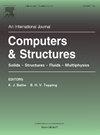动态系统物理空间参数的预测:POD-ANN方法
IF 4.8
2区 工程技术
Q1 COMPUTER SCIENCE, INTERDISCIPLINARY APPLICATIONS
引用次数: 0
摘要
全阶模型(FOM)参数提供了动态系统的详细表示。然而,它们通常伴随着高昂的计算成本。这对于结构健康监测和数字孪生等大规模或实时应用尤其如此。降阶建模(ROM)技术,如适当正交分解(POD),通过降低系统维数来解决这个问题。这使得更有效的模拟,同时保持基本的动态。然而,ROM方法不能直接用于预测物理空间中的参数(例如,刚度)。这些参数对于系统的综合评价至关重要。该研究引入了一种结合POD和人工神经网络(ANN)的新框架,用于将全局参数逐渐变化的情况下的降阶参数映射到物理参数。POD提取捕获基本动态的重要模式,将全阶动态投射到简化空间上。随后,训练人工神经网络将约简空间映射到物理空间参数,解决ROM的局限性。将POD-ANN模型应用于线性和非线性动态问题,在这两种情况下,与全阶维相比,模态减少了50%。此外,在预测线性和非线性动力系统的全阶刚度矩阵时,所获得的相对误差很低。模型经过训练后,可以有效地进行参数预测。本文章由计算机程序翻译,如有差异,请以英文原文为准。
Prediction of physical space parameters for dynamical systems: A POD-ANN approach
Full-Order Models (FOM) parameters provide detailed representations of dynamic systems. However, they often come with high computational costs. This is especially true for large-scale or real-time applications such as structural health monitoring and digital twinning. Reduced-Order Modeling (ROM) techniques, like Proper Orthogonal Decomposition (POD), address this by reducing system dimensionality. This enables more efficient simulations while preserving essential dynamics. However, ROM approaches cannot be used directly to predict parameters (e.g., stiffness) in the physical space. These parameters are crucial for comprehensive system evaluation. This study introduces a novel framework combining POD and Artificial Neural Networks (ANN) to map reduced-order parameters to physical parameters for the case of gradual, global parameter variations. POD extracts significant modes that capture essential dynamics, projecting full-order dynamics onto the reduced space. Subsequently, ANN is trained to map reduced space to physical space parameters, addressing ROM’s limitations. The POD-ANN model is applied to linear and nonlinear dynamic problems, and reduction in modes compared to the full-order dimension is observed in both cases. Furthermore, the achieved relative error is quite low while predicting the full-order stiffness matrix for linear and nonlinear dynamical systems. Once the model is trained, it can be used to predict parameters efficiently.
求助全文
通过发布文献求助,成功后即可免费获取论文全文。
去求助
来源期刊

Computers & Structures
工程技术-工程:土木
CiteScore
8.80
自引率
6.40%
发文量
122
审稿时长
33 days
期刊介绍:
Computers & Structures publishes advances in the development and use of computational methods for the solution of problems in engineering and the sciences. The range of appropriate contributions is wide, and includes papers on establishing appropriate mathematical models and their numerical solution in all areas of mechanics. The journal also includes articles that present a substantial review of a field in the topics of the journal.
 求助内容:
求助内容: 应助结果提醒方式:
应助结果提醒方式:


